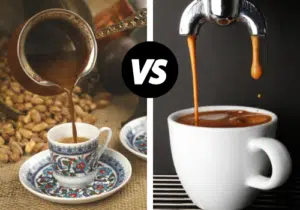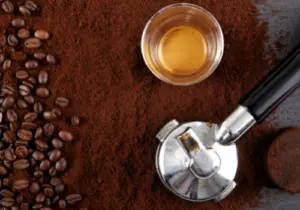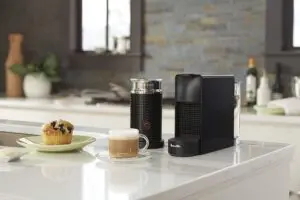How To Grind Coffee For French Press - A Barista Weighs In
Disclosure: This post contains affiliate links and I may earn a small commission (at no extra cost to you) if you click through and make a purchase. Thanks in advance – I really appreciate it!
Underestimating the importance of perfect French press grind size is one of the most common mistakes even the most advanced coffee lovers make. If the grinds are too coarse, it can result in a cup that tastes sour, acidic, and salty. On the other hand, if the grinds are too fine, your coffee will turn out to be dull, bitter & over-extracted.
Key Takeaways:
What’s the ideal grind size for French press coffee?
The French press brewing method calls for a coarse, uniform coffee grind size. As a general rule, follow a 1:12 ratio of coffee to water. For every 1 gram of coffee, add 12 grams of water, which converts to approximately 4 tablespoons (19 grams) of coffee for every 1 cup (227ml) of water.
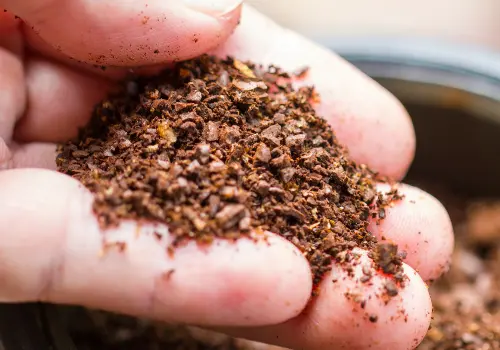
In this article, I am going to help you understand the importance of the best French press coffee grind size and how to achieve it with minimum effort.
The Best Grind Size For French Press
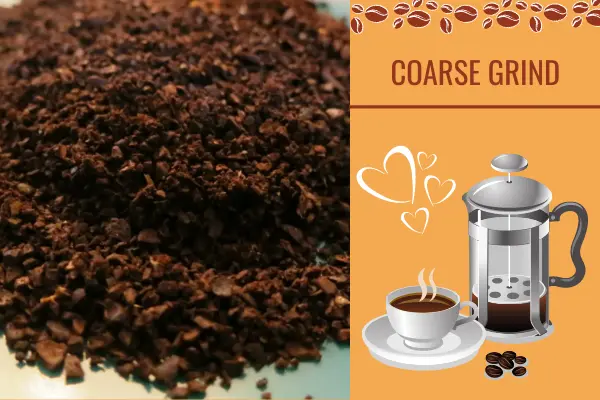
French presses feature a classic mesh filter that keeps grounds out of your coffee, but if the grounds are too small, they tend to get stuck in the filter.
The wrong grind size can also mean your coffee brews way too fast or too slow. This destroys your coffee’s flavor and makes it either way too bitter or even sour, which is disappointing for your taste buds.
The best grounds to use for French press coffee are – the coarser grounds. Coarse coffee grounds are roughly the size of coarsely ground pepper or sea salt.
Coarse grounds are perfect for the French press as they don’t get stuck in the filter. However, since they’re extra-big, they take a little longer to reach the optimum flavor – that’s why the normal French press recipe has a 4-minute steep time.
Why Does French Press Need Coarse Grind
A French press requires a coarse, consistent grind because coffee is steeped in boiling water and maximum water surface area is necessary for full flavor extraction. Grinding the coffee too coarse will result in weak and less flavorful coffee. Grinding too fine will make the coffee dull and bitter.
Coffee beans contain soluble solids, which must be extracted from the grind into the brew. It’s essential that the correct balance is achieved during this process to yield the best flavor from the beans.
Ideally, the brew strength for a cup of French press coffee is around 98.5 percent water to between 1.15 to 1.35 percent of brewed solids. And as I already mentioned, proper extraction occurs only across the maximum water surface area.
Grind size has a direct impact on the surface area. French press coffee needs between 100 and 300 particles of grounds for the perfect brew, whereas espresso needs around 3,500 particles.
Also, uniform coffee grind size is vital for the perfect brew. Unevenly ground coffee can result in either under or over-extraction, producing a bitter-tasting brew.
Therefore, the particle size, uniformity of grind size, and correct brewing time are all essential for a perfect cup of French press coffee.
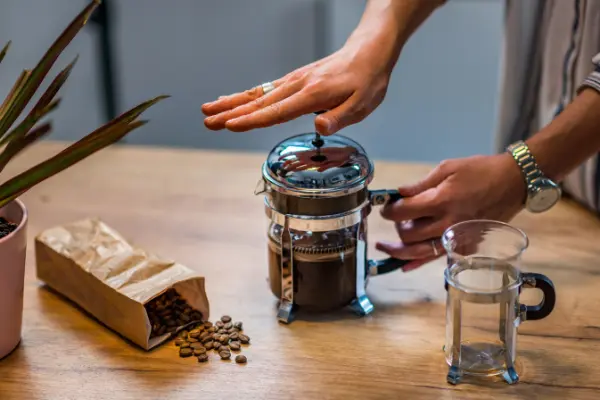
Blade Vs Burr Vs Manual Grinder For French Press Coffee
The key to brewing a great cup of French press coffee (or any coffee) is consistency, and if your little grinds are not all the same size, some will be over-extracted, some will be under-extracted, and the result will be dull bitter coffee.
Blade Grinders
Although they are less expensive and widely available, blade Grinders really aren’t grinders at all. They are basically a coffee processor.
The blade inside the unit doesn’t cut the coffee beans, instead, the blade basically whirls around really fast, slinging the beans all over the chamber, busting the beans to pieces.
This process creates a mix of boulders and fines. This leads to uneven extraction and hurts the flavor of your brewed coffee.
Also, blade coffee grinders can only work by spinning extremely fast, which causes heat and friction. This heat and friction mean your coffee is already heating up so it won’t taste as fresh and the end result will be overcooked coffee.
Needless to say, blade grinders are not the best option to grind coffee for your French press.
Burr Grinders
Burr grinders are the best grinders for grinding coffee for all brewing methods, including the French press.
Burr grinders really do grind the coffee beans. They grind beans between two burred plates. The plates, or “burrs”, are flat in some models and conical in others. One plate remains stationary, while the other spins around.
The main advantage of a burr coffee grinder is that it grinds beans to a uniform size of particles. This makes for a better cup of French press coffee, avoids clogging problems, and gives you the flexibility to grind beans to the ideal French press grind size.
Manual Grinders
Manual coffee grinders give you the best of both styles by offering a consistent grind for a fraction of the cost. They have become the preferred choice of a growing community in the specialty coffee world due to their versatility and reliability.
Moreover, manual grinders produce uniform consistent grind while being quiet and without needing any electricity.
Using a manual coffee grinder is a chance to go analog for part of your day, to unplug and simply focus on the task at hand.
Popular Burr Grinder Settings For French Press
In this article I have tried my best to make your life easier, with that in mind I have compiled this table with French press grinder settings for most of the popular burr grinders available in the market today.
I apologize in advance if you cannot find your grinder in this table, I have only included the ones that I assume most people will have in their kitchens.
| Grinders | Grind Setting |
|---|---|
| Baratza Encore | 31 - 36 |
| Baratza Virtuoso | 8 - 9 |
| Baratza Vario | 8 - 9 |
| Capresso Infinity | 12 - 14 |
| Cuisinart Supreme Grind | 14 - 16 |
| Bodum Bistro | 11 - 13 |
| OXO Brew Burr Grinder | 11 - 13 |
| Hario V60 | 34 - 40 |
| KRUPS Burr Grinder | 13 - 15 |
Why Do You Have To Grind Coffee Beans
Coffee beans need to be ground in order to break the bean’s surface to increase the surface area coming into contact with water. This also releases coffee bean’s aromas and flavors. When hot water passes over the grounds it captures oils, aromas, and flavors, transferring them to the brewed coffee.
Coffee beans have a very hard surface and a “wood-like” structure. Due to the bean’s form, water alone cannot adequately extract the coffee’s flavor. The roasted surface of the coffee bean acts almost like a shell protecting the coffee’s natural oils.
When coffee is ground, the bean’s surface is broken up exposing more surface area inside of the bean. This process unlocks the coffee bean’s smell, taste, etc. This is why a quality grinder is important to the end result. A good grinder produces more of a uniform particle size allowing the coffee to extract evenly.
How To Make French Press Coffee
Easy to brew and super consistent, the French Press is very reliable. Its classic and well-engineered design hasn’t changed much since its invention in 1929, and it’s perfect for making multiple cups of coffee in 4 minutes.
You’ll Need:
- French Press – For 2 cups
- Coffee – 38 g (4 Tbsp), coarsely ground
- Hot Water – 200° F, 465 g (2.25 cups), just off the boil
Step 1 – Preheat
Preheat your French press with hot water, make sure to include the plunger as well.
While your French press is warming up (for ~30 seconds), it’s a perfect time to grind your coffee beans.
Use your burr grinder to grind coffee grounds with the coarseness of sea salt. After 30 seconds, empty hot water from your carafe. Now, your French Press is warmed up!
Step 2 – Add your coffee
Add freshly roasted coffee to your carafe. Give a gentle shake to make sure that grounds are evenly leveled.
Step 3 – Add Water
Starting the timer, add water in a circular motion, wetting all the grounds, until the press is half full. Pause and enjoy the bloom.
After 30 seconds, the blooming process is complete, and your coffee will become bubbly and increase in volume.
Give it a gentle stir with a wooden spoon (anything of your choice) to break the crust.
Step 5 – Add more water
Pour over hot water to fill the carafe rest of the way. Add the lid and lower plunger just a bit till the mesh slightly touches the water surface.
Do not push the plunger all the way down yet.
Step 6 – Let it brew
Start your timer and wait for four minutes while your coffee is brewing.
Step 7 – Plunge & Pour
Now, you can press the plunger all the way down. Please make sure to push it gently and slowly without applying extra force.
Next and right away, decant your coffee into a favorite cup or a container. Please do not leave it sitting in a carafe to avoid over-extraction and, therefore, bitterness in your coffee.
Avoid pushing the plunger too fast and too hard. It will agitate your coffee grounds and might add bitter flavors to your coffee.

Amit Gupta
Hi, my name is Amit Gupta, and I am the owner and contributor at Cafeish. My obsession with coffee started when I received my first French press as a gift almost ten years ago. Since then, my love of coffee – and the number of coffee gadgets I own – has grown considerably.
Most Popular
ABOUT US
We are a team of coffee affcianados with experience and expertise in making world renowned coffee. In fact, preparing the best coffee ever with a fluffy top reminds us of magic, with secrets of how to achieve each particular effect. Making coffee is not our only hobby, we always keep our ears open as to what’s happening around and what scientists and manufacturers produce for consumers. It’s not an easy task to do – it’s rather time consuming. Hence, Caféish website was launched.
LEGAL DISCLAIMER
Caféish is a participant in the Amazon Services LLC Associates Program, an affiliate advertising program designed to provide a means for sites to earn advertising fees by advertising and linking to Amazon.com. Caféish also participates in affiliate programs with Clickbank and other sites. Caféish is compensated for referring traffic and business to these companies.

